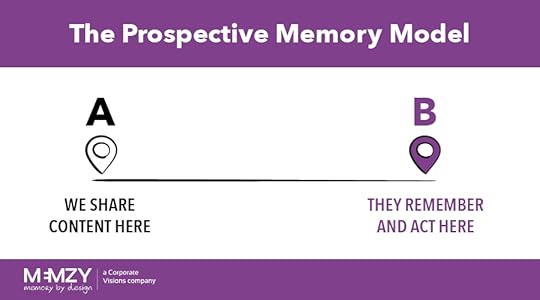How to Make Sure Your Buyers Remember Your Message
The post How to Make Sure Your Buyers Remember Your Message by Carmen Simon appeared first on Corporate Visions.

The Science of Memorable Content
If you’re in Sales or Marketing, you’re in the business of influencing other peoples’ choices.
Every time you communicate with your buyers, it’s an
opportunity to move them in some way—to change, to choose you, or to stay with
you instead of switching to a competitor.
There’s just one big obstacle in your way: Most people will
forget up to 90 percent of what you communicate. And they’ll forget it rather
quickly.
People act on what they remember, not what they forget. So,
if you want to persuade your buyers to act in your favor, you should make sure
your message sticks in their minds.
You need to become part of their memory.
The latest scientific research places memory at the heart of decision-making. Studies show that in the process of making a decision, your brain predicts the rewards of a choice based on past memories, and then uses that information to make the most favorable decision.
Think about that. The brain is a prediction engine. And memory
is the fuel that helps it make better decisions. Memory doesn’t just keep track
of the past; it helps you navigate the future.
The Prospective Memory Model
Your buyer’s decision to purchase will happen in the future,
but you can influence those decisions in your favor now.
Prospective Memory means “remembering a future intention,”
and using this model has remarkable advantages for every seller and marketer.
Imagine this for a moment: You create content at Point A, hoping your audience remembers and acts on it at Point B. The skilled presenter knows how to communicate information at Point A, so it creates a future intention at Point B and motivates their audience’s decisions based on that intention.

Influencing Future Buying Decisions
Getting your buyers to act on what they remember always
starts with an intention they either already have or one you want to plant in
their minds.
Research says that people act on future intentions when they
complete these three steps:
Notice Cues that are linked to their
intentionsSearch their memory for something related
to those Cues and intentionsAnd execute on their intentions if
something is rewarding enough
With this Prospective Memory Model in mind at Point A, you
can prime your audience with the proper Cues, help them keep what’s important
in their long-term memory, and make it easier for them to execute on intentions
at Point B.
Most business content leaves the process of Prospective Memory completely to chance. As a result, your audience forgets a lot, and the little they randomly remember doesn’t always lead to action.
So, how can you create more effective and more memorable content?
Three Steps to Influence Memory and Decisions
When you ask your buyers at Point A to act on a future
intention, they strike a tacit deal with you. They implicitly say, “I will stay
with you to Point B as long as you keep me rewarded.”
No rewards, no action.
Your buyers will look for rewards at all three stages of the
decision process: when they notice Cues, when they search their memory for
connections between their intentions and those Cues, and when they decide to
execute. Here’s how you can influence these three steps:
1. Create Cues
People always intend to do something next. Cues are signals
or triggers that something must be done at a specific time, or during a specific
event.
For Cues to work, they must be both distinctive enough and
tied to an intention people care about.
2. Bridge Cues and Intention
After noticing a Cue, your buyer will search for a memory
related to that Cue and their intentions to act.
If the Cue and intention are sufficiently linked in your
content, and if they notice the Cue when it counts, your buyer will act on
their intention.
3. Motivate Decisive Action
People will only act on their intentions if the result is
rewarding enough. But memory doesn’t influence action on its own—emotion and
motivation also play a part.
Together, the three processes predict, measure, and recall
the rewarding (or punishing) outcomes of a choice. Are you making it clear how
your content enables others to move toward something rewarding?
Make Your Content Impossible to Ignore
Using the Prospective Memory Model when creating sales and marketing content, your goal is to become part of your buyer’s future.
You create content and share it at Point A, connect it to
your buyer’s intention, and encourage them to remember to act on it at Point B.
Using this approach, you can intentionally place memories in people’s minds and
use Cues to guide them toward future action.
Memory works on the basis of associations—one thing can
trigger another. What Cues exist in your buyers’ world that can trigger
memories of you? How will you influence what you want them to remember, instead
of leaving the process to chance?
The brain is searching constantly for the next and biggest
reward. In the process, it balances ease and exploration. It goes back to
low-effort habits that have proved rewarding in the past. And it seeks to learn
new information that brings better rewards.
Are you going to be part of your buyer’s next reward? When you develop highly memorable content that hooks into rewards from the past but also provides new sources of rewards, you become impossible to ignore.
Get our new e-book, Impossible to Ignore: The Science of Unforgettable Content, to learn how you can build highly memorable content that drives future decisions.
Thank you for reading this post from Corporate Visions - Differentiate Your Marketing Messages and Sales Conversations.
Timothy Riesterer's Blog
- Timothy Riesterer's profile
- 3 followers



